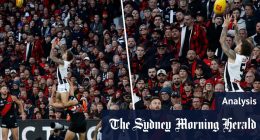
This month, Los Angeles-based nonfungible token (NFT) artist Ellie Pritts is celebrating “In the Screen I am Everything,” her first solo show in New York City — and her first time taking over pioneering net art gallery Bitforms.
Eight animations from the technicolor exhibition are available to mint as NFTs on Ethereum, displayed on screens alongside a few physical prints. The multilayered process Pritts used for all three series on view unites them across media.
Pritts broke onto the NFT scene in 2021 when she tried minting a few existing video artworks — and watched them take off.
“I had this cache of video art,” Pritts told Cointelegraph. “I’d put it on Instagram or in different projects, but I certainly didn’t think there was any way I could ever monetize it.”
Her video practice had been mostly therapeutic, but suddenly the blockchain boom made her work valuable enough to fund the acquisition of new tools, which Pritts used to make more sophisticated video artwork.
Magazine: Experts want to give AI human ‘souls’ so they don’t kill us all
She’d shot concert photography before the COVID-19 pandemic and performed as a professional cellist — until 2021 also forced her to confront medical issues she’d been avoiding, like her newfound inability to hold her bow. Pritts made a New Year’s resolution to begin painting portraits in early 2021 but couldn’t use a pencil to draw preliminary sketches.
“I went to the doctor, through a lot of testing, and found out I have this degenerative neurological condition,” Pritts recalled. “They had no answers or comfort. They said, ‘You’re losing these abilities, they’re not going to come back, we don’t know how much worse it’s gonna get. Sorry.’”
Introducing artificial intelligence
Pritts began leaning into artificial intelligence (AI) upon receiving her diagnosis. Her show at Bitforms opens with “Relative Minor” (2023), a trippy animation mounted alone in the entryway’s tangerine alcove. In the work’s foreground, a feminine face conjured by Stable Diffusion zooms infinitely inwards, morphing through colors, expressions and angles atop a glitch art background Pritts made herself using vintage, circuit-bent hardware she acquired from a now-reviving breed of artisans.
[embedded content]
“Relative Minor” is a sneak peek of the show’s eventual climax. The work’s central visage is AI’s vision of text prompts from Pritts’ dream journals. She has hundreds of pages of self-history on Google Docs, and physical diaries from her sleeping and waking lives going back to age nine.
Dream material makes for particularly great prompts, though, Pritts said, “because I can create libraries and themes that keep coming up in my own subconscious.” One theme, the divine feminine, drove most of this show. Pritts coaxed the AI’s biases to achieve archetypal faces that didn’t read quite so stereotypically pretty as the algorithm thought they ought to be.
Pritts then ran the AI’s animation through video hardware from the 1990s, resoldered to produce visually warped outputs. “That’s basically what glitching is,” she said. Still sensing the work wasn’t complete, she created its background with a modular video synthesizer, “which works really similar to a modular audio synthesizer with little cables,” Pritts said. “Same thing, but it’s video output.” She’s made probably 20 such animations so far — this exhibition collects seven.
Glitching flowers
Next, viewers enter the flashing garden of Pritts’ “Fleur Glitch” series, where flowers bloom and wilt on film — a shine, flash frozen and brilliant in polychromatic giclee prints. The artist applied techniques from her recursive dreamscapes to footage of cut flowers. Some footage is her own; some is from stock websites. Rather than mounting the floral animation atop her synthesized glitch graphics, though, Pritts incorporated digital abstractions into the interior of these flowers’ shifting forms. With each passing moment, they present shifting portals into alluring digital voids.
[embedded content]
“It’s a cool juxtaposition between nature,” Pritts stated, “And the texture of something completely manmade and computerized.” Bitforms founder Steven Sacks told Pritts she should isolate and present a few frames from the animations. They’re hung on the lemon-hued walls surrounding a mural Pritts also installed, composed of stills from this series. The prints resemble silkscreens, evoking Andy Warhol and drawing profound parallels between his superstars and Pritts’ blooms.
Self-exploration through AI
The show’s final room opens on a wonderland of six framed screens illuminated by Pritts’ surreal scenes, a spectacle scintillating with the movement of varied tempos and directions. A few works even feature momentary cameos from Pritts herself. The affair begins with a still homage, however — two new prints from her “Divine Recursion” series, which she’d initially planned to paint with her hands, but debuted at Bitforms’ groundbreaking AI show in San Francisco in fall 2022.
After her diagnosis, Pritts took the collection of preliminary sketches she’d been able to finish and used machine learning to build a model that would depict her. She fed that model her sketches as visual prompts, paired with text prompts from her journal — this time from her waking life, where she often wondered what it’d be like to feel more confident. Pritts found the results deeply personal. She added final flourishes using the graphics editing software Procreate.
“These are extra recursive because they’re based off [AI] paintings I did the first round,” Pritts said of the portraits. “That was an earlier version of Stable Diffusion. We’re three versions later.”
Painting first attracted Pritts because she wanted more tactility in her practice. Due to her health and evolving external technology, Pritts has mostly gotten her hands dirty metaphorically, in a collaboration between the artist’s conscious and subconscious — empowered by AI’s mysterious ability to envision what we only have words for.
“It’s kind of a magical process because you don’t know exactly what part of the prompt is affecting the output,” Pritts said. “One of the first ones I did, part of the prompt was talking about wanting to feel better about myself, increasing my self-worth, carrying myself with confidence. I didn’t know what the hell that was going to give me. None of that draws an image in my head.” For the first time, Pritts fully understood what it’d look like to live as a queen — courtesy of AI.
The perfect moment
Only the show’s titular artwork evades the confines of a frame, displayed via projector to provide a more immersive viewing experience. It depicts Pritts coyly positioned before a greenscreen in her studio — she added AI and manual edits after. Then she ran that amended video through her circuit-bent hardware “to give it that warmth and texture,” Pritts said. If this show’s printed portraits portray her past, and the framed dreamscapes her present, this work is Pritts’s future.
[embedded content]
“If I wasn’t alive right now, at this moment in time, a lot of doors could be closing for me because of physical issues,” the artist said. “I feel the opposite, like doors opening for me.”
Recent: EU stays on top of Web3 with metaverse, AI and crypto strategies
Blockchain first helped Pritts find new acclaim, audiences and income. On-chain transactions still help her sell work with integrity. Now the tech’s also sustaining her continued explorations in AI, thus helping her manifest a regal self that once felt impossible.
“Having that outlook when I’m starting a project has a huge impact, even if it’s psychological,” Pritts said. “To not walk into things thinking, ‘how am I going to do it?’ but instead, ‘I can do anything.’ I never felt that until recently.”
What’s next? Hard to say. AI is always evolving.
Read More: World News | Entertainment News | Celeb News
Cointelegraph









